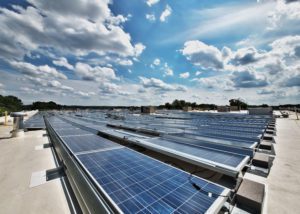Energy storage technology – meaning stationary batteries – has been in the news quite a bit in recent months, with CEOs of large companies making bold predictions about how the the technology will grow and how important it will be for consumers and businesses alike. I’m not about to rain on their parade, because I largely agree with them. But I do want to offer a dose of reality: it will take a lot more than batteries to make their predictions come true.
First, let’s review. Tesla Motors CEO Elon Musk got the ball rolling in April with a splashy announcement of a battery system designed for homes, businesses and utilities. As Forbes reported:
The show-and-tell, which was streamed live, highlighted Tesla’s intention to build a business selling equipment to store solar electricity for later use, offer backup power and provide electric-grid regulating services that have traditionally been performed by natural gas power plants. All these uses are part of an energy storage market that is emerging alongside the rise of solar and wind energy generation in the United States and abroad.
In September, Jim Robo, CEO of NextEra Energy said his company would invest “probably $100 million” in energy storage projects in the coming 12 months. As Greentech Media reports:
Robo said that he and his team expect energy storage prices to experience a similar cost plunge to that of solar costs over the last seven years. If that happens, energy storage will be competitive with gas peaker plants.
Robo said, “Post-2020, there may never be another peaker built in the United States — very likely you’ll be just building energy storage instead.”
These are exciting developments indeed. And the battery technology they’re referring to – lithium ion (Li-ion) – does represent game-changing technology. Li-ion batteries can store far more energy at a lower cost than previous generations of batteries, which have been dominated by lead acid technology.
But the battery is only one piece of the puzzle when it comes to the kinds of applications that Musk and Robo have in mind. You also need rectifiers to convert power from AC to DC, for storage on the battery, and inverters to convert it back to AC for distribution to the load.
It takes distribution systems to get the power from one place to another, whether from a rooftop solar panel to a battery pack in the garage of a home, or from a utility power source to a large battery array intended to power an entire building.
You need various enclosures and racks to hold all of this equipment, much like those you see in data centers. Similarly, depending on the size of the storage system, you may also need ventilation or cooling systems. All of these systems will need to be intelligent, able to report on their status to some faraway monitoring site – especially for utility storage systems that may be located in remote areas.
It takes sophisticated software systems to supply that intelligence and to make sure all the components are working together as intended. The software also needs to be smart enough to know when battery power is needed, such as to avoid peak energy periods in a building demand reduction scenario.
This is the type of infrastructure and software that Schneider Electric has been providing for commercial buildings, data centers and utilities for decades. We’ve poured all of that experience into EcoBlade, a scalable energy storage solution that’s pre-engineered so that it’s simple to install. It’s also highly scalable, suitable for entire grids, private homes or anything in between. And it has a great deal of intelligence built in, inspired by our decades of work with IT environments.
That’s why we, too, are excited about the types of applications on the horizon for Li-ion battery technology. Because what Schneider has introduced with EcoBlade is so much more than a battery. It is a family of appliances and energy storage stations that empowers users to shift their energy use in real time. And it does so more intelligently, affordably, and easier than ever before.




Conversation
Again we are ignoring the fact that one cannot go 100% wind and PV on a grid system due to lack of inertia and the much needed aspect of a lot of storage which MUST cater for the coincidence of darkness and no wind. The exception is of course hot sun heated salt. Not much use in Northern climes!
There will be a market up to say 70% penetration for PV wind and battery storage. (Most have in common power electronics which need additional costly mods to supply reactive current (VArs) into grid to assist with voltage support during grid events/disturbances.)
I see in the final analysis a mixture of PV Wind, sun powered (Hot salt), some gas peaker plants which hopefully over time can be phased out, no nuclear and storage in the form of already mentioned hot salt, batteries, flywheels for grid regulation and pumped hydro for most of the rest.
Last but not least. What do we do with catastrophic events like Yellowstone cauldera, large asteroid strike, etc. Some nuclear might be useful then! OR do we continue to let the voters hear what they wish to hear?
Thank you for responding to my post.
I agree that we are in desperate need for innovations which address the shortcomings of today’s electricity grid and power generation system. Very likely such breakthroughs will come from the minds and labs of engineers and will take multiple forms and embodiments.
Storage is one of the key missing links in the scenario you described – from energy security to integrating multiple sources of energy more efficiently.